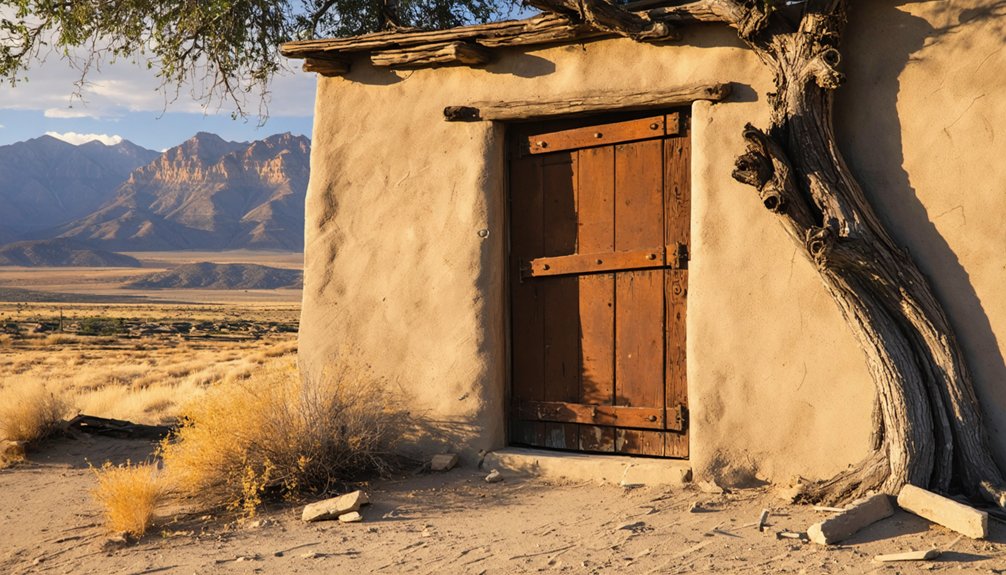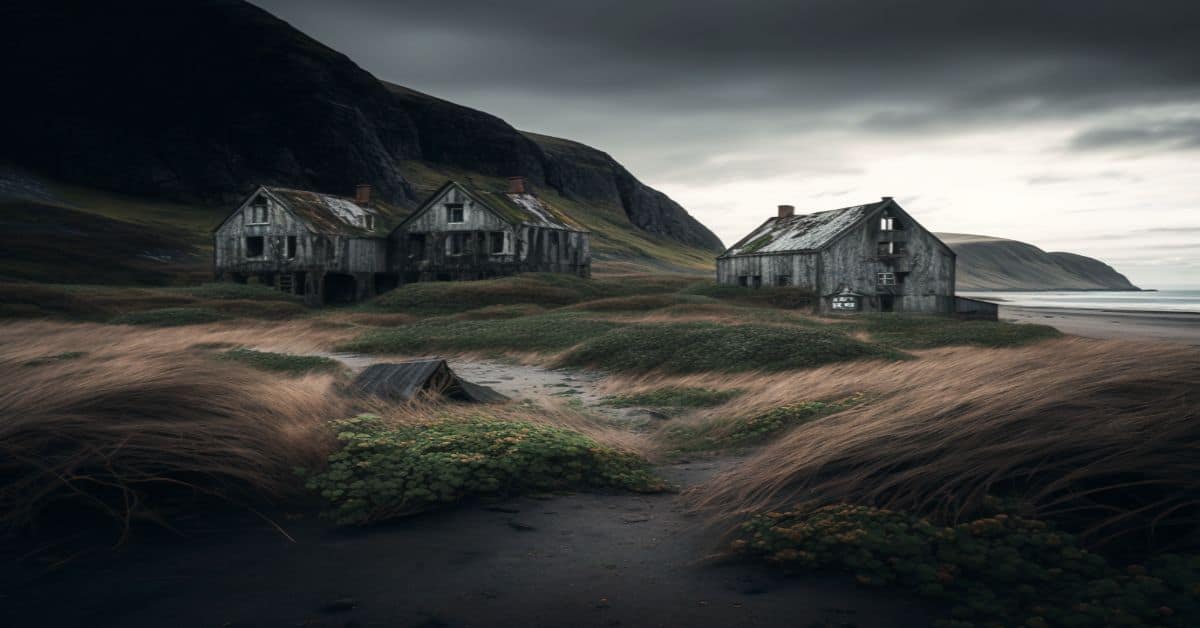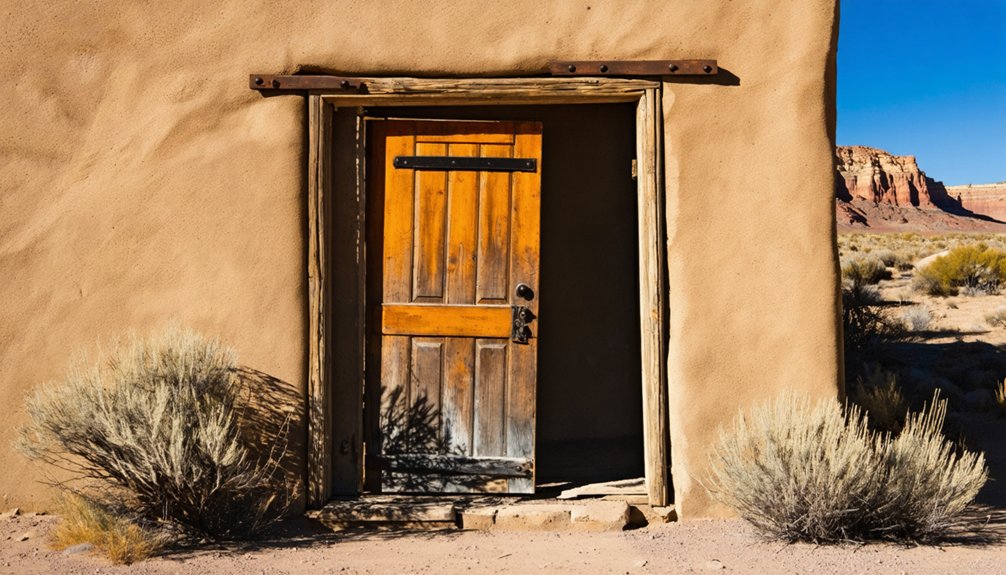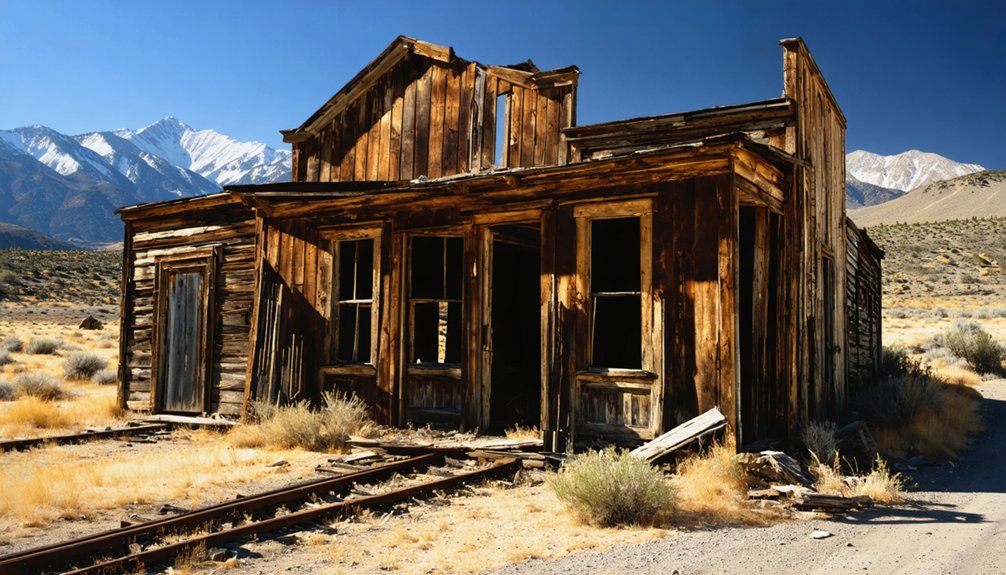You’ll find Round Valley’s ghostly remains where thirteen Mormon pioneer families carved out a settlement in Utah’s rugged terrain during the late 1850s. Initially named Craball, this community thrived around its L.D.S. meetinghouse and schoolhouse, with settlers developing extensive farmland and irrigation systems. Though Brigham Young himself visited in 1863, the town couldn’t overcome its challenges, leaving behind artifacts and stories that reveal the complexities of frontier life.
Key Takeaways
- Round Valley was established in 1863 by thirteen Mormon pioneer families and was initially named Craball before its final naming.
- The settlement featured a church, schoolhouse, and general store, serving as primary community gathering places until its abandonment.
- Agricultural challenges, including poor soil conditions and short growing seasons, contributed significantly to the town’s eventual decline.
- The closure of the post office marked a symbolic end to Round Valley’s active community life.
- Today, 2,200 acres of the former settlement are protected for historical preservation, containing artifacts that reveal untold stories.
The Birth of a Pioneer Settlement
When Latter-day Saint pioneers first ventured into Round Valley in the late 1850s, they established a settlement that would undergo several transformations in its early years.
You’ll find that thirteen determined families braved the rugged canyons from Salt Lake to create their new home, initially calling it Round Valley, then briefly Craball.
Like other settlements during this era, the colony was part of the church-directed colonization effort that shaped Utah’s early development.
The pioneer challenges they faced demanded strategic thinking, leading to Brigham Young’s 1863 visit and recommendation to relocate the settlement away from the mountains for better security.
This pivotal decision shaped the settlement dynamics as the community adopted a more organized approach, laying out a central plaza and establishing a structured townsite.
They built one-room homes that they’d later connect with mud walls, adapting their architecture to meet both living and defensive needs. The settlement was renamed Scipio A. Kenner in recognition of a prominent local figure.
Natural Landscape and Geography
The rugged terrain that challenged those first thirteen pioneer families remains a defining feature of Round Valley today.
Time has preserved Round Valley’s wild character, its untamed landscape still echoing the challenges faced by its first settlers.
You’ll find dramatic natural formations where the valley floor stretches four miles wide, flanked by towering mountain fronts that rise over 3,000 feet above. The landscape’s striking geographic features were shaped by two major faults that created the valley’s elongated form. Several hazardous deep sinkholes dot the valley floor, with the largest measuring 80 feet wide and 60 feet deep. The valley’s distinctive geology includes light gray limestone that forms prominent ledges throughout the region.
Key features you’ll encounter:
- Fractured sandstone outcrops of the Oquirrh Formation, with distinct yellow-brown orthoquartzite in the north
- Deep brushy canyons where mountain streams descend to feed the valley’s waterways
- Broad valley floor layered with ancient deposits of gravel, sand, and volcanic ash
The valley’s 2,200 acres now evolve from historic farmland to protected spaces, where you’re free to explore trails beneath those same commanding peaks that watched over the pioneers.
Early Settlers and Their Stories
As you explore Round Valley’s early days, you’ll find Kumen Tarbet’s remarkable story of breaking the first ground with his team of oxen in 1861, establishing essential farmland from the sagebrush-covered terrain.
His pioneering efforts with primitive plowing equipment laid the foundation for agricultural development in the area, inspiring other settlers to follow suit with similar land-clearing methods. The valley, which was originally called Round Valley, would later be known as Oxford.
While Tarbet’s initial settlement sparked the community’s growth, families like the Asays would later contribute to the valley’s expansion through their own homesteading efforts and participation in communal projects like well-digging and crop cultivation. The community faced significant challenges as water access was difficult for both household and agricultural needs.
Kumen Tarbet’s Pioneer Journey
Born in 1888 to pioneering parents Nephi Tarbet and Deborah Ann Smith, Kumen Tarbet emerged as a pivotal figure in Round Valley’s evolution from railroad camp to farming settlement.
You’ll find his legacy deeply woven into the area’s agricultural foundation, where he faced pioneer hardships with remarkable determination.
Through agricultural innovations and sheer grit, Tarbet helped establish a thriving farming community where only sagebrush and bunchgrass once stood. His methods included:
- Manual clearing of wild terrain using rails and controlled burns
- Shifting from oxen to more efficient mule and horse teams
- Implementing systematic land development techniques that turned harsh terrain into productive farmland
Tarbet and fellow settlers struggled with poor water quality from local wells, making farming even more challenging. Tracing his roots to the Isle of Man through his grandfather Thomas, Tarbet’s story exemplifies the pioneering spirit that transformed Utah’s rugged landscape into sustainable agricultural communities. He lived a long and productive life until his death at age 83 in 1971.
Asay Family Settlement Legacy
Pioneering settlers Joseph and Sarah Asay carved out a new life in 1872, establishing their homestead three-quarters of a mile west of what you’d now recognize as Asay Creek, Utah.
At 7,000 feet elevation, they found a lush meadow perfect for cattle grazing, with nearby timber-rich mountains supporting a crucial sawmill operation. A notable moment in the settlement’s history came when John Wesley Powell stopped to rest during his famous Grand Canyon expedition.
The Asay family’s influence shaped the settlement’s character through Jerome’s general store and post office, while Grandma Sarah served as the community’s trusted midwife.
You’ll find their legacy in the multipurpose log building that housed church services, education, and social gatherings. Isaac and James Dutton served as the community’s spiritual leaders.
Though the community thrived for over 25 years, the sawmill’s destruction in the late 1890s marked the beginning of its decline.
Yet the Asay family’s spirit of community resilience lived on through their descendants in surrounding towns.
Building a Thriving Community
As you explore Round Valley’s early social fabric, you’ll find a community that organized itself around key Mormon pioneer institutions established after the 1863 founding.
The settlement quickly developed leadership roles through the L.D.S. meetinghouse, where residents gathered for both religious services and town meetings.
Local children attended lessons in the schoolhouse, which served as another essential hub for community activities and social gatherings until the town’s decline in the early 1900s.
Early Leadership Roles
When Round Valley was established in 1863, its founding leaders quickly recognized the need for robust governance structures to guarantee the settlement’s survival.
Early community governance focused on coordinating essential resources and managing relations with neighboring Southern Paiute tribes to maintain peace. Leaders implemented irrigation management systems to maximize the arid valley’s agricultural potential through hand-dug ditches and water rights allocation.
Key leadership responsibilities included:
- Organizing communal farming systems and equitable land distribution
- Coordinating infrastructure projects like canals, roads, and defensive structures
- Developing trade networks with nearby settlements while fostering local markets
These early leaders adapted policies to address emerging challenges, from coordinating evacuations during conflicts to establishing resource-sharing programs that strengthened the community’s self-reliance and economic resilience.
Church and School Activities
The establishment of Round Valley’s church and school in 1914 marked a new chapter in the settlement’s social development, building upon the community’s early governance foundations.
Peter Jensen served as the first Presiding Elder, while education began in a converted house before moving to a purpose-built schoolhouse in 1915.
These institutions became essential centers for community bonding and cultural preservation. The church building hosted social gatherings, dances, and community forums, while the school evolved from a one-room structure to a two-room facility after a fire.
Teachers integrated into local life by boarding with residents, strengthening social ties. You’d find both institutions working together to maintain traditions and values, with the Blue Creek Store and boarding house supporting their activities until the school’s closure in 1934.
Agriculture and Economic Activities
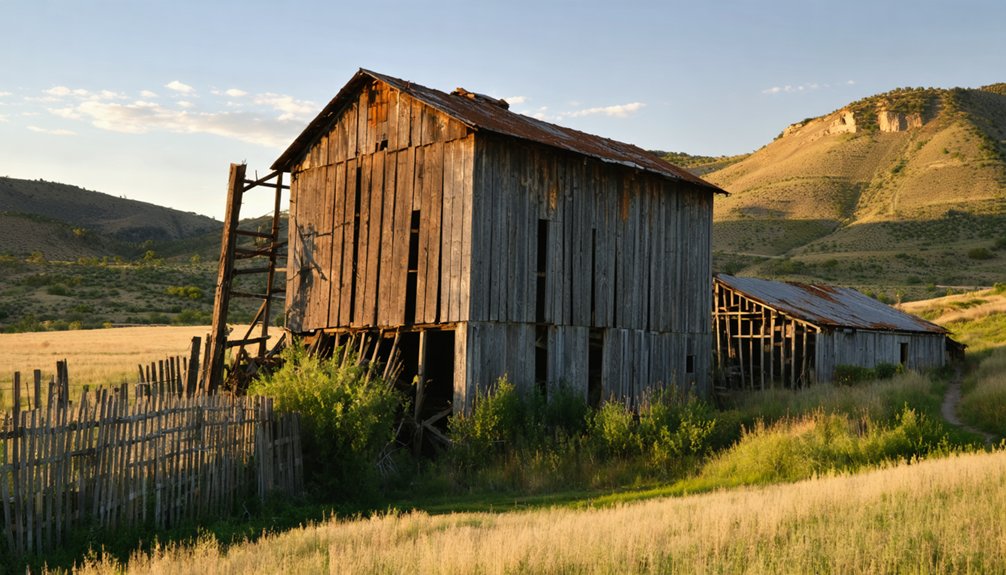
Mormon pioneers established Round Valley’s agricultural foundation in the early 1860s, transforming the untamed landscape into farmable terrain through intensive labor.
You’d find settlers clearing dense sagebrush and bunch grass, implementing basic crop rotation and irrigation techniques to cultivate the valley’s fertile soil. Water accessibility proved essential, with settlers digging wells up to 400 feet deep to sustain their farming operations.
The settlement’s economic significance depended entirely on agricultural success, with three key characteristics:
- Reliance on communal water sources for both crops and livestock
- Labor-intensive farming using oxen, later replaced by mules and horses
- Focus on staple grains and vegetables adapted to Utah’s arid climate
Without mining or railroad alternatives, Round Valley’s fate rested solely on farming success until the reservoir project forced residents to relocate.
Daily Life in Round Valley
As you walk through Round Valley’s remaining structures, you’ll find evidence of a once-vibrant community life centered around the general store and local church where residents gathered for social events and worship.
The town’s farming families spent their days tending to crops and livestock, often coming together to assist neighbors during harvest times and barn raisings.
Religious services and community celebrations brought the scattered homesteaders into town regularly, fostering strong social bonds despite the distances between farms.
Community Gathering Places
Despite its remote location, Round Valley fostered a vibrant community life centered around several key gathering places that shaped daily interactions among settlers. The multi-purpose church building anchored community bonds through services, weddings, and holiday celebrations, while the one-room schoolhouse hosted educational events and evening lectures that strengthened gathering traditions.
- General stores and trading posts served as crucial hubs where you’d exchange news, barter goods, and collect mail.
- Seasonal barn dances, picnics, and outdoor sports brought everyone together for entertainment and fellowship.
- The town hall and shared infrastructure, like communal wells, created natural meeting points for daily connections.
These gathering spots wove together the social fabric that sustained Round Valley’s isolated but close-knit population through the challenges of frontier life.
Farming and Ranching Activities
Life in Round Valley revolved around the daily rhythms of farming and ranching, where settlers cultivated cotton, corn, wheat, and sorghum while managing extensive cattle operations.
You’d find families practicing sustainable practices through crop rotation and dry farming techniques, guided by research from Utah State Agricultural College’s local experimental station.
Your daily routine would’ve included tending to livestock, maintaining irrigation canals, and working the fields from sunrise to sunset.
You’d store your harvest in barns, make cheese from your cattle’s milk, and trade surplus goods with neighboring communities.
Even after floods damaged farmland in 1862, you’d adapt your planting strategies to overcome nature’s challenges.
Religious and Social Events
While Round Valley’s early religious services began in a modest log house, this humble structure soon became the heartbeat of community life.
You’d find James Dutton and Isaac Asay leading pioneer gatherings as presiding elders, guiding both spiritual worship and community affairs. The building served multiple purposes, hosting both religious customs and educational activities that shaped daily life.
Key aspects of Round Valley’s religious and social structure included:
- Regular church meetings that doubled as community forums
- Educational sessions combining academic and religious instruction
- Seasonal celebrations that strengthened community bonds
Notable Figures and Local Leadership
As Round Valley took shape in 1863, its founding leaders emerged from pioneering Mormon settlements to establish a thriving farming community. The early pioneer governance centered around influential landowners and religious figures who managed irrigation systems and directed land distribution throughout the verdant valley.
You’ll find the Osguthorpe family among the most significant leaders who shaped the community’s development through their extensive landholdings and agricultural initiatives.
When the post office opened in 1902, trusted community members took on essential administrative roles, strengthening local community dynamics. These postmasters handled official records and coordinated communication between residents.
Religious leaders played dual roles in Round Valley’s development, providing both spiritual guidance and civic leadership while organizing social gatherings and directing settlement patterns until the town’s population declined by 1930.
The Path to Abandonment
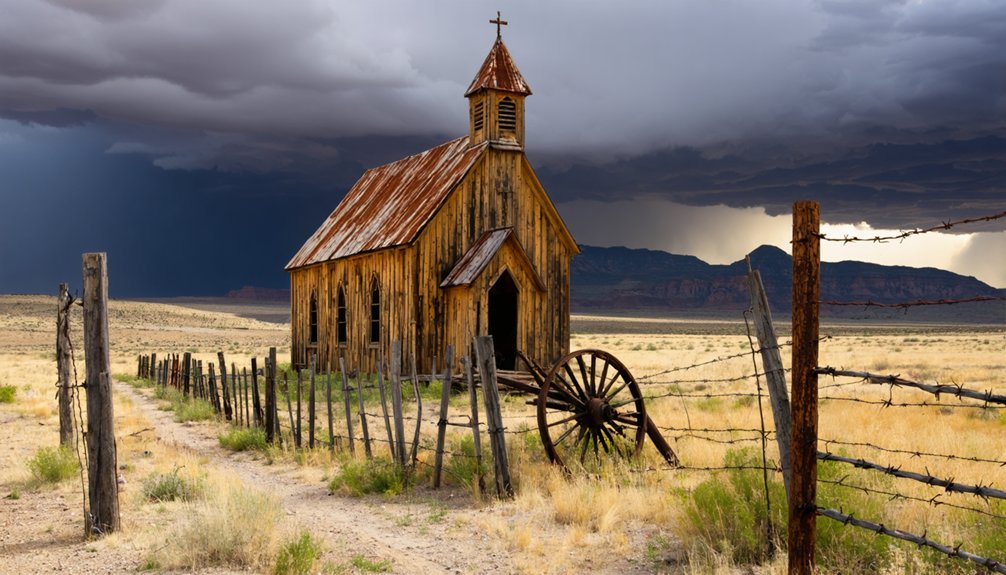
Despite Round Valley’s promising start in 1863, the settlement’s inherent challenges quickly emerged to shape its destiny toward abandonment. The community decline accelerated through a combination of harsh environmental conditions and economic isolation, leading to significant migration patterns by the early 1900s.
- Agricultural struggles dominated daily life, with short growing seasons and difficult soil conditions limiting farmers’ success.
- Geographic isolation restricted trade opportunities, while nearby towns with better conditions drew residents away.
- By 1930, the settlement had largely emptied as families sought more feasible locations for their futures.
The final blow came as regional transportation routes bypassed the valley, leaving those who remained with dwindling resources and opportunities.
The post office’s closure in the early 1900s marked a symbolic end to Round Valley’s brief period of liveliness.
Historical Legacy and Preservation
Since its abandonment in the early 1900s, Round Valley’s historical footprint has grown increasingly significant through archaeological discoveries and preservation efforts.
You’ll find this cultural heritage protected within 2,200 acres of conserved land, where archaeological significance emerges through artifacts that tell untold stories of Chinese workers and other marginalized groups.
Recent excavations have unearthed Chinese currency, porcelain, and food remnants that weren’t documented in official records. These discoveries have reshaped understanding of daily life and social dynamics in Round Valley.
Today, land trusts actively manage the site, ensuring both natural and historical preservation while providing free trail access.
Though challenges like illegal metal detecting and natural deterioration persist, collaborative conservation efforts between public entities and community groups continue to protect this invaluable piece of Utah’s multicultural past.
Round Valley’s Place in Utah Settlement History
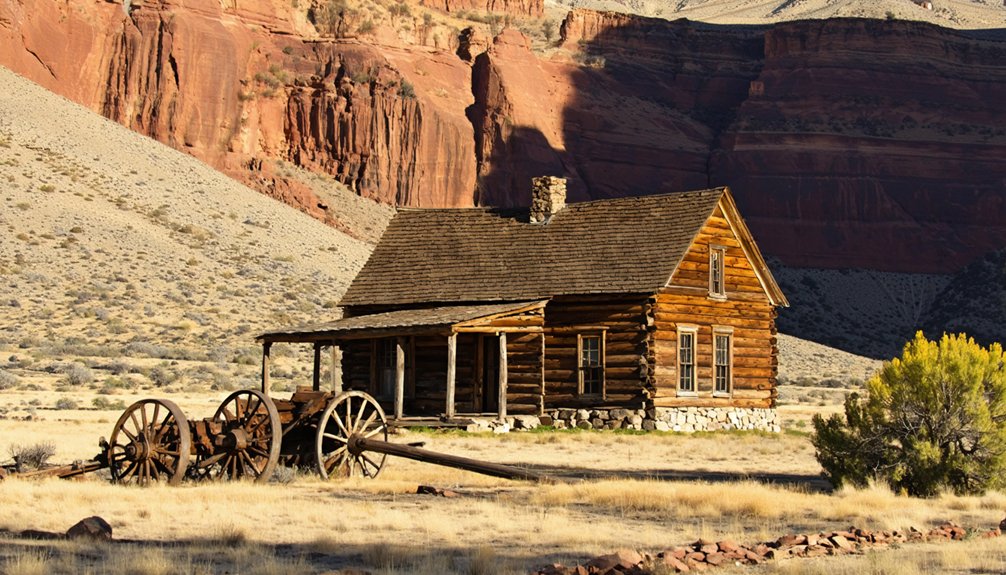
When thirteen Latter-day Saint families established Round Valley in 1863, they marked a significant milestone in Utah’s territorial expansion.
You’ll find their settlement patterns aligned perfectly with Brigham Young’s vision for colonizing remote valleys, as Round Valley emerged during the third wave of Mormon expansion beyond the Wasatch Front.
The settlers demonstrated remarkable foresight in their indigenous relations, securing permission from local Bannock and Shoshone tribes before establishing their community.
Early Mormon settlers wisely sought approval from Bannock and Shoshone tribes before founding their Round Valley community.
Their strategic approach helped shape Round Valley’s role in broader settlement efforts.
Key aspects of Round Valley’s historical significance include:
- Serving as a vital outpost in Bear Lake Valley’s development
- Contributing to Rich County’s formation in 1864
- Strengthening Mormon presence in northeastern Utah before non-Mormon settlers arrived
Frequently Asked Questions
Are There Any Remaining Structures or Ruins Visible in Round Valley Today?
Like ghosts of the past, you’ll find limited evidence of remaining structures in the area. Historical significance suggests foundations and partial ruins might exist, but no documented standing buildings survive today.
What Happened to the Original Sawmill and Shingle Mill Equipment?
You’ll find no clear records of the sawmill history or equipment preservation – the machinery was likely dismantled, abandoned, or repurposed when residents left and the mills ceased operations around 1900.
Did Any Families Return to Round Valley After Its Abandonment?
You’ll find no family stories or historical records showing anyone’s return to those quiet, windswept foundations. The harsh climate and isolation kept families away after they’d packed up and left by 1930.
Can Visitors Access the Ghost Town Site by Public Roads?
You can’t drive directly to the site – access routes end at trailheads where you’ll need to hike in. For visitor safety, vehicles aren’t permitted beyond designated parking areas.
Were There Any Documented Paranormal Activities or Ghost Stories From Round Valley?
You’ll find haunted legends about a ghostly “White Lady” who lost family in mining accidents, with visitors reporting eerie encounters including disembodied voices, mysterious touches, and apparitions near abandoned mine shafts.
References
- https://boydhouse.com/alice/Cameron/roundvalley.html
- https://jacobbarlow.com/tag/ghost-towns/page/3/
- https://www.familysearch.org/en/wiki/Utah_Ghost_Towns
- https://www.deseret.com/2016/7/23/20592661/the-tiny-town-that-set-out-to-be-utah-s-capitol-and-4-other-areas-with-a-unique-history/
- https://expeditionutah.com/ghosttowns/
- https://beyond.nvexpeditions.com/utah/millard/scipio.php
- https://www.uen.org/utah_history_encyclopedia/c/COLONIZATION_OF_UTAH.shtml
- https://www.hmdb.org/m.asp?m=75459
- https://archiveswest.orbiscascade.org/ark:80444/xv44747
- https://digitallibrary.utah.gov/aw-server/rest/product/purl/USL/i/0d7ecfda-c9ed-4b4a-9a2a-84dfcce74170
